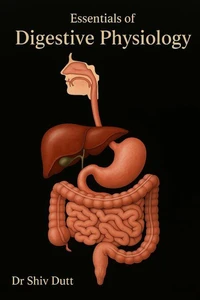Neurophysiology: The Working Nervous SystemThis comprehensive textbook provides an in-depth understanding of the human nervous system, from the microscopic structure of neurons to the complex networks responsible for movement, sensation, memory, and higher brain functions. Written in a clear, systematic style, it is designed for students of medicine, BAMS, nursing, pharmacy, and allied health sciences, bridging foundational physiology with clinical relevance.
Highlights of Contents Foundations of Neurophysiology- Organization and classification of the nervous system- Neurons, glial cells, nerve fibers, and myelination- Properties of nerve fibers and mechanisms of conduction Neurotransmission & Synapses- Neurotransmitters and neuromodulators- Neuromuscular transmission and clinical disorders- Synaptic mechanisms, EPSPs, IPSPs, inhibition, plasticity Reflexes & Applied Neurophysiology- Reflex arc and types of reflexes- Stretch, tendon, superficial and postural reflexes- Clinical relevance of abnormal reflexes Cerebral Cortex & Higher Functions- Functional areas of the brain (motor, sensory, association)- EEG and electrical activity of the brain- Learning, memory, speech, emotion, and sleep Diencephalon, Basal Ganglia & Limbic System- Thalamus, hypothalamus, epithalamus, and subthalamus- Basal ganglia circuits and their clinical importance- Limbic system, hippocampus, amygdala, and behavior Cerebellum & Brainstem- Nuclei, connections, and role in motor control- Midbrain, pons, medulla oblongata and their functions Spinal Cord & Tracts- Ascending and descending pathways- Upper vs lower motor neuron lesions- Clinical conditions including Brown-Séquard syndrome Peripheral & Autonomic Nervous Systems- Spinal nerves, dermatomes, cranial nerves- Sympathetic, parasympathetic, and enteric systems Sensory Systems- Pain, temperature, and somatic sensations- Vision: retina, visual pathways, color vision, field defects- Hearing and vestibular apparatus- Taste and olfaction Key Features?? Systematic, organ-wise coverage of neurophysiology?? Clinical notes linking physiology with practice?? Diagrams, flowcharts, and summary tables for clarity?? Suitable for MBBS, BAMS, Nursing, Pharmacy, and Allied Health students
Neurophysiology: The Working Nervous SystemThis comprehensive textbook provides an in-depth understanding of the human nervous system, from the microscopic structure of neurons to the complex networks responsible for movement, sensation, memory, and higher brain functions. Written in a clear, systematic style, it is designed for students of medicine, BAMS, nursing, pharmacy, and allied health sciences, bridging foundational physiology with clinical relevance.
Highlights of Contents Foundations of Neurophysiology- Organization and classification of the nervous system- Neurons, glial cells, nerve fibers, and myelination- Properties of nerve fibers and mechanisms of conduction Neurotransmission & Synapses- Neurotransmitters and neuromodulators- Neuromuscular transmission and clinical disorders- Synaptic mechanisms, EPSPs, IPSPs, inhibition, plasticity Reflexes & Applied Neurophysiology- Reflex arc and types of reflexes- Stretch, tendon, superficial and postural reflexes- Clinical relevance of abnormal reflexes Cerebral Cortex & Higher Functions- Functional areas of the brain (motor, sensory, association)- EEG and electrical activity of the brain- Learning, memory, speech, emotion, and sleep Diencephalon, Basal Ganglia & Limbic System- Thalamus, hypothalamus, epithalamus, and subthalamus- Basal ganglia circuits and their clinical importance- Limbic system, hippocampus, amygdala, and behavior Cerebellum & Brainstem- Nuclei, connections, and role in motor control- Midbrain, pons, medulla oblongata and their functions Spinal Cord & Tracts- Ascending and descending pathways- Upper vs lower motor neuron lesions- Clinical conditions including Brown-Séquard syndrome Peripheral & Autonomic Nervous Systems- Spinal nerves, dermatomes, cranial nerves- Sympathetic, parasympathetic, and enteric systems Sensory Systems- Pain, temperature, and somatic sensations- Vision: retina, visual pathways, color vision, field defects- Hearing and vestibular apparatus- Taste and olfaction Key Features?? Systematic, organ-wise coverage of neurophysiology?? Clinical notes linking physiology with practice?? Diagrams, flowcharts, and summary tables for clarity?? Suitable for MBBS, BAMS, Nursing, Pharmacy, and Allied Health students

 , qui est-ce ?
, qui est-ce ?